Homemade Pappardelle Pasta Recipe
Learn how to make homemade pappardelle pasta at home. This simple traditional egg pasta dough is made with all-purpose flour, semolina, and eggs. Make a traditional version or naturally color the dough (pink!) with beet puree.
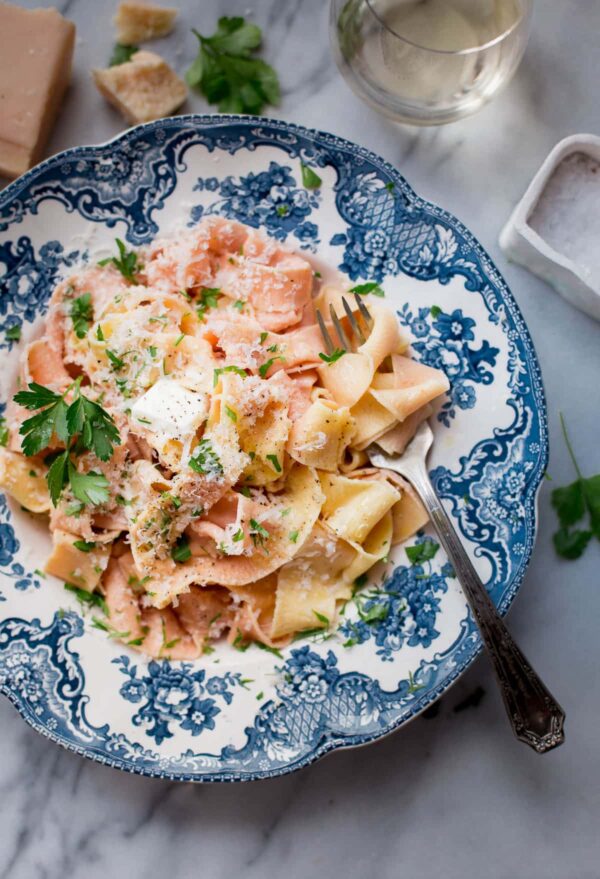
Pasta is my love language.
I can’t remember the first time my mom made me pasta (probably the ripe age of six months or somewhere around there), but it was love at first sight. Unequivocal, unconditional love. The kind of love that made me swear off practically every other food group for years. Let’s all take a moment and pretend that we have a giant vat of this in front of our faces right now. Aaah.
This homemade pappardelle pasta speaks to me. It is so dreamy and wonderful. Oh, oh! And it is pink. Or at least, it can be pink if you wish to make homemade colored pasta. The best kind of pastelle pink. I took Valentine’s Day very seriously this year. It also happened to be a fabulous excuse to break out the pasta machine and get cranking. I can’t think of a better way to celebrate a special occasion than with a giant bowl of homemade pasta. It is one of life’s greatest pleasures and I mean that with all of my pasta-loving heart.
Ok, so here’s the deal. Four years ago, I shared a recipe for homemade red pasta and well…it was in dire need of a face-lift. This pasta dough is different in a few ways: we’re using a different base recipe, we’re tinting the pasta dough with beet puree (*I have a beet problem), and we’re going to cut it by hand into wide pappardelle strands. Homemade egg pappardelle is one of my all-time favorite pastas, particularly in the winter months and for special occasions, as its wide strands lends itself extremely well to richer cream or meat-based sauces.
Let’s get started. [PS. If you don’t feel like making your pasta from scratch, you can buy the dry packaged variety and make this leek and pancetta pappardelle. It just happens to be scaled down for two.]
What You’ll Need to Make Homemade Pappardelle Pasta:
If you’ve never made homemade pasta before, you’re going to feel like an Italian superhero after you make this. Promise. Technically, this pasta can be made without a pasta machine or roller. To do this, you’ll need a rolling pin, a touch more enthusiasm, and a bit of arm muscle – but it is possible!
With that said, I used a pasta machine for this pasta. If you love pasta and own a KitchenAid stand mixer, I highly recommend this attachment. It frees up both of your hands and makes homemade pasta much more time-friendly and fun.
After making a lot of homemade pasta back in the day (both for fun, in culinary school, and at the restaurant where I worked), I’ve come to realize that I greatly prefer homemade pasta doughs made with a combination of all-purpose flour and semolina flour. Preferably, a 50/50 ratio of both.
What is Semolina Flour?
Semolina (durum wheat) is a coarse grain made exclusively from the endosperm of wheat kernels. It is lightly golden in color and contains a higher amount of gluten and protein than other standard flours. My partner Bob’s Red Mill happens to sell a wonderful semolina flour if you can’t find any.
Due to its higher gluten properties, semolina provides pasta with great structure and that slight chew that we’ve all come to appreciate and love. I prefer the texture of semolina-blend homemade pastas over strictly all-purpose or type 00 flour based pastas, which tend to be almost too delicate in my opinion. It comes down to preference!
How to Make Pappardelle Pasta:
Gather your ingredients (eggs, semolina, all-purpose flour, salt – and beet puree, if you’re in the mood for some color!). Keep a container of all-purpose flour close for easing grabbing. Here’s what we’re going to do:
Whisk together the flour, semolina, and salt in a small bowl. Dump the flour mixture into a pile on your clean countertop (yep, we’re going to make the dough by hand – it is much easier than dirtying up a machine, promise!).
Create a large well in the center of the dry ingredients and add the eggs (and beet puree, if using!). Using a fork, start to whisk the eggs.
Keep whisking, slowly bringing the dry ingredients into the eggs, until the dough slowly begins to form. It will be very shaggy and wet. As you continue bring in more dry ingredients, it will get easier to handle. At this point, leave the fork behind and use your hands (and a bench scraper, if you have one!).
Gather the dough together and start to press it together. It will be fairly sticky and scraggly at this point.
Knead the pasta dough – it will be firm and dense – for about 10 minutes. Set a timer. Dust the dough lightly with all-purpose flour if it is sticking to your countertop. You want it be slightly tacky, but not sticky. The dough will get smoother and more elastic as you continue to knead it.
Get your arm workout in for the day. Once kneaded, divide the dough into two portions and pat it into a thick disc. Wrap it in plastic wrap and allow it to rest at room temperature for at least 30 minutes (or up to one hour!). This allows the gluten to relax, making it easy to roll and shape, and allows the pasta dough to absorb the dry ingredients. Don’t be tempted to skip this step.
Set up your pasta machine and start rolling your dough! Turn on some great music and enjoy the process. Marvel at your skills. Homemade pappardelle is right around the corner.
Continue rolling the dough until you reach setting ‘4’ on your pasta machine. For pappardelle, I prefer a slightly thicker noodle. But this is up to you and your own preference!
If you add even more beet puree than this recipe calls for, you can achieve a very dark, hot pink colored beet pasta. Similar to this! I chose not to do this, because I wanted more a muted pink color once cooked. You won’t taste the beet. I loved the look of both the traditional yellow and pink pappardelle pasta paired together in one bowl.
Alternatively, you can skip the beet pasta altogether and just make a double batch of the traditional pasta. Once the dough is rolled, we’re going to fold the long pasta strips like an envelope and cut them into 1/2-inch wide ribbons. Don’t worry if they’re not perfect.
Once all of your pappardelle pasta is prepared, bring a lot pot of salted water to a boil. You want the pot to be big enough for the pasta noodles to have ample room to spread out and cook evenly (*the pasta will also expand as it cooks, so avoid using a small pot).
Prepare whatever sauce you are using (this creamy leek and pancetta sauce would be great for this!) or toss with a tab of butter, freshly ground pepper, a touch of pasta cooking water, and a generous dusting of parmigiano-reggiano cheese.
Heaven in a bowl!
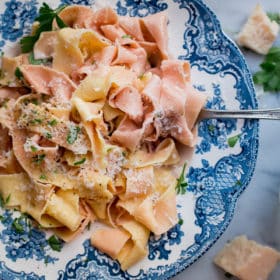
Homemade Pappardelle Pasta Recipe
Equipment
Ingredients
Traditional Pappardelle Pasta:
- ½ cup (70 g) unbleached all-purpose flour plus more for kneading and dusting
- scant ½ cup (85 g) semolina flour
- ½ teaspoon kosher salt
- 1 large egg, plus 2 large egg yolks
Beet Pappardelle Pasta:
- ¾ cup (100 g) unbleached all-purpose flour plus more for kneading and dusting
- scant ½ cup (85 g) semolina flour
- ½ teaspoon kosher salt
- 1 large egg, plus 2 large egg yolks
- 2 tablespoons beet puree see notes for directions
Instructions
- If you are preparing both pasta doughs (for a dual-color effect once cooked), prepare each dough, one at a time, according to the instructions below. If you prefer to make one pound of just one type of dough, double the recipe quantities for that dough and proceed as follows – but portion the kneaded dough into four pieces for rolling, instead of just two.
- Prepare the pasta dough: In a small bowl, whisk together the all-purpose flour, semolina, and salt. Place the dry ingredients in a pile on a clean countertop and create a well in the center with your hands. Make sure the sides of the well are deep enough to hold the wet ingredients.
- Add the eggs (and beet puree, if preparing the beet pappardelle). Using a fork, whisk the eggs together. Continue to whisking the eggs, slowly adding the flour mixture from sides of the well into the egg mixture. Keep working until the dough is shaggy and just beginning to come together, and the egg mixture is no longer runny.
- Using floured hands (or a bench scraper), continue to incorporate any remaining dry ingredients into the dough until it comes together. Knead the dough, dusting it with all-purpose flour as necessary to keep it from sticking to the countertop, for 10 minutes until it is smooth and very elastic. It should be slightly tacky, but not sticky. Divide the dough in half, flatten into a thick disk using your palm, and wrap each portion tightly in plastic wrap. Allow the dough to rest at room temperature for 30 minutes or up to 1 hour.
- Roll the Pasta Dough: Line a sheet pan with parchment paper (or dust lightly with semolina flour) and set aside. Working with one portion of dough at a time, unwrap the dough from the plastic wrap and lightly dust with flour (as it rests, it will absorb the flour and become more tacky). Flatten the dough into an oval that is no more than ½-inch thick. Gently feed the dough (at the largest-width setting) through an electric or manual pasta machine. Repeat four more times, dusting the dough lightly with flour if it is sticking.
- Continue to roll the pasta dough through the machine, adjusting the knob by one turn – slowly narrowing the opening with each turn – until you reach setting “4” on your pasta machine (or to your desired thickness). Cut the sheet of pasta in half. At this point, you can trim and discard any scraggly ends or sides. Place the sheets on the parchment-lined baking sheet and allow to dry for about 5 minutes before cutting. Lightly dust the top of the pasta sheet with flour and fold in half. Dust lightly and fold in half once more. Using a large chef’s knife, cut the pasta lengthwise into ½-inch wide strips. Don’t worry if they are not perfect. Dust with noodles with semolina and gently transfer them to the parchment lined sheet pan (I like to gather them in several small loose nests to make it easy to add them to the past water) until ready to cook. Repeat this process with the remaining portions of pasta dough.
- Cook the Pasta: Bring a large pot of salted water to a boil. Add the pappardelle pasta, and stir to prevent any sticking. Cook the pasta, stirring occasionally, until until al-dente (*depending on the thickness of your pasta, the time will vary but it should only take about 2 to 3 minutes at most). Drain and serve pasta as desired.
Recipe Yield Notes:
- Each pasta dough recipe above (classic or beet) makes about 1/2 lb of fresh pasta. If you prefer to make 1 lb of just one color of fresh pasta, double the quantity of that particular dough recipe and follow the same instructions, except divide the dough into four portions for rolling, instead of two.
Tips for Success:
- To make your own beet puree, drain one (15-ounce) can of cooked beets – packed in water – in a fine-meshed sieve. Place the drained beets in a small food processor and puree until very smooth, scraping down the side of the bowl with a spatula as needed.
- Store and refrigerate any unused beet puree in the refrigerator for up to 3 to 4 days. I like to add leftover beet puree to smoothies. You can also use it for cakes and other baked goods.

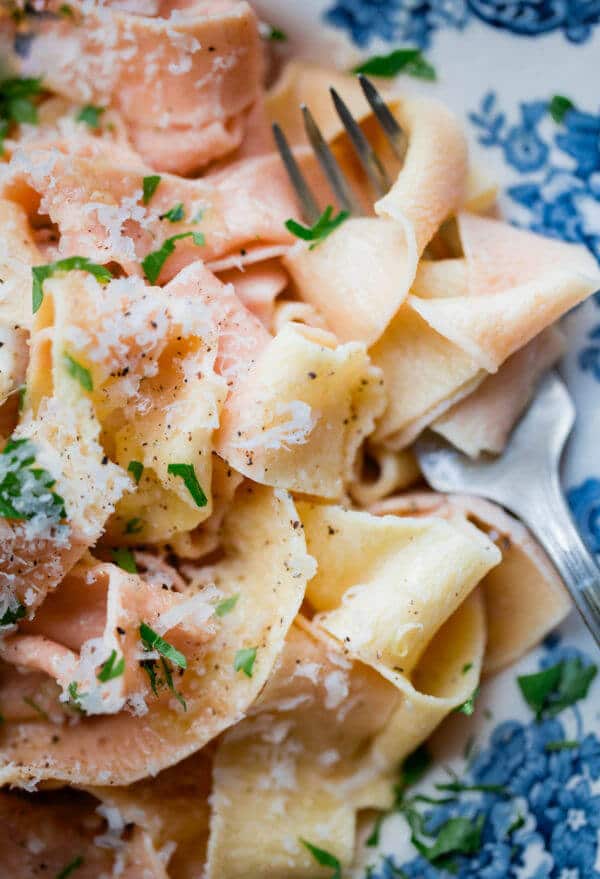
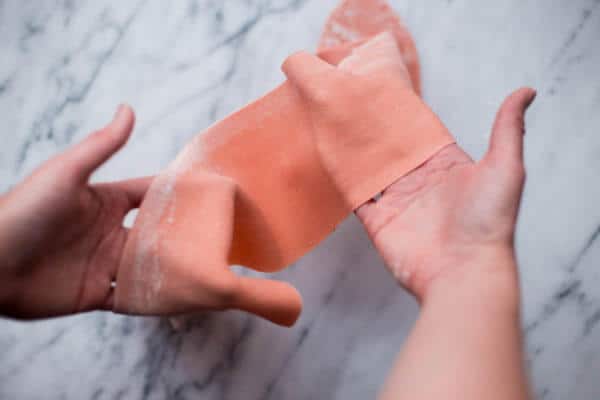
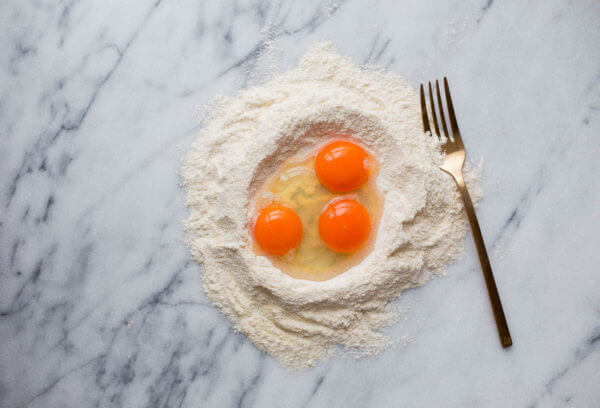
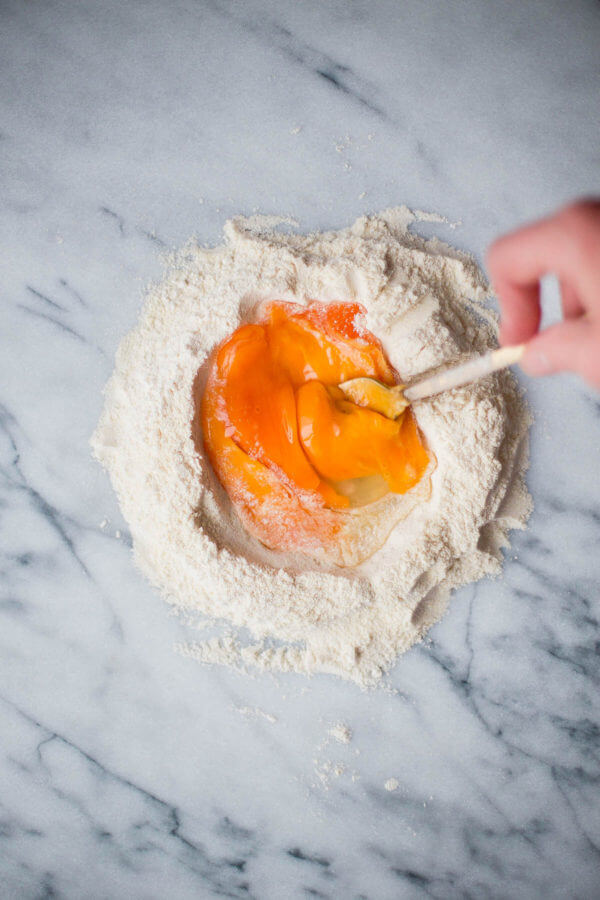
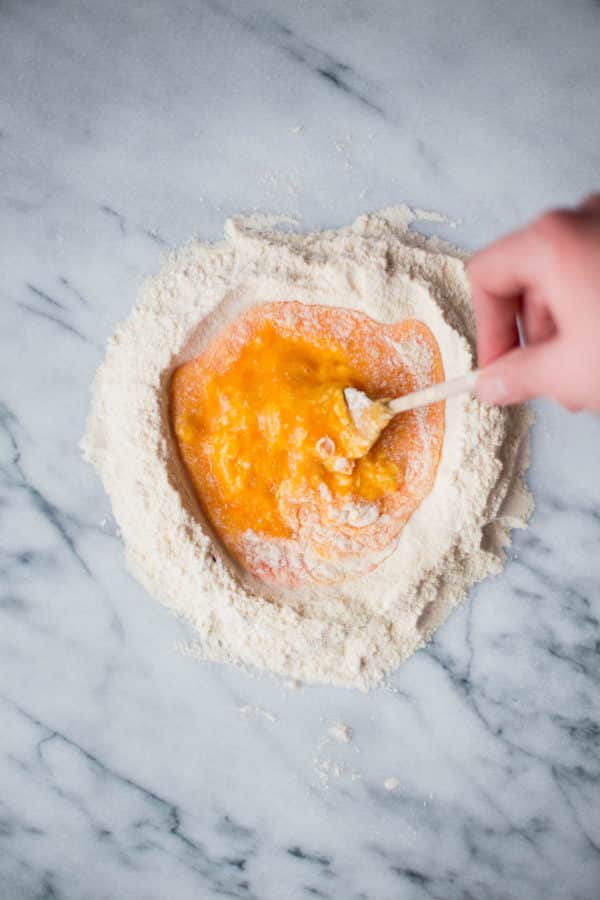
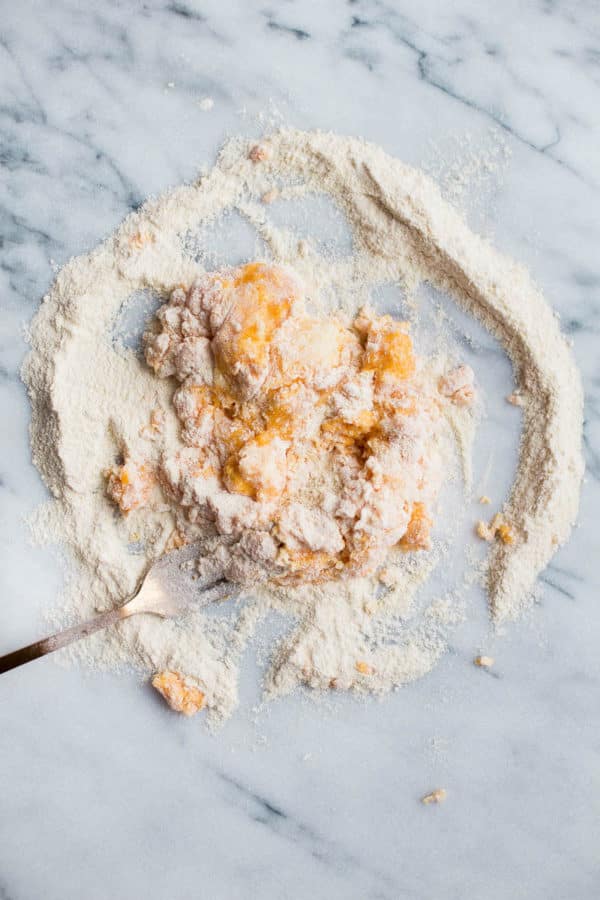
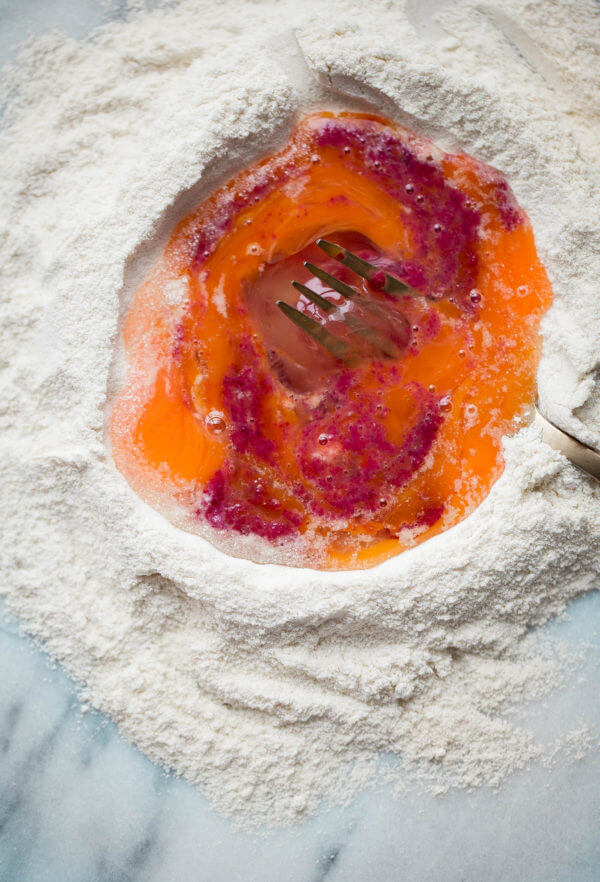
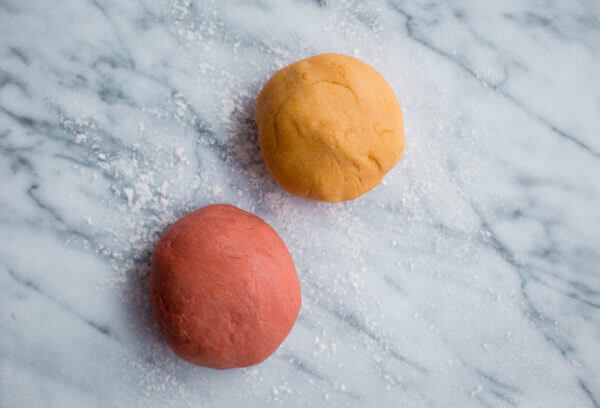
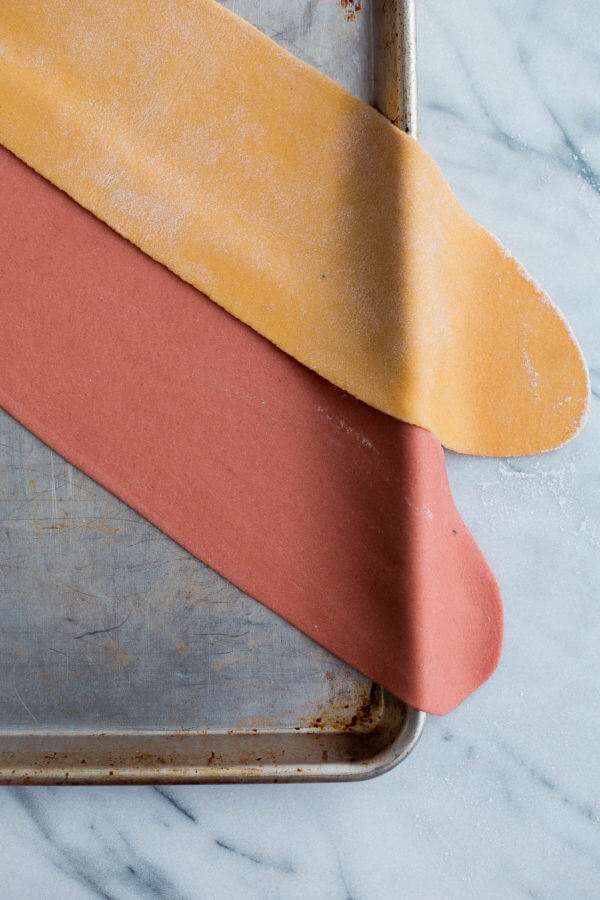
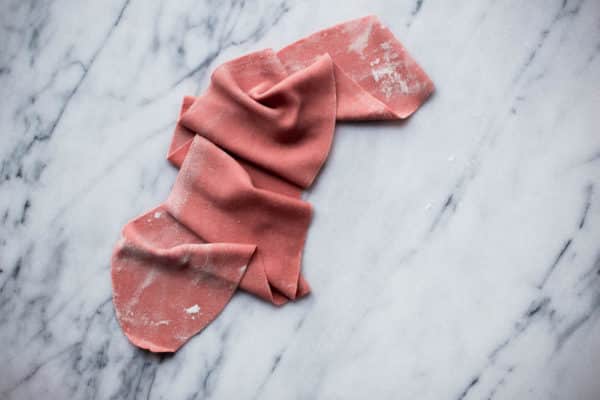
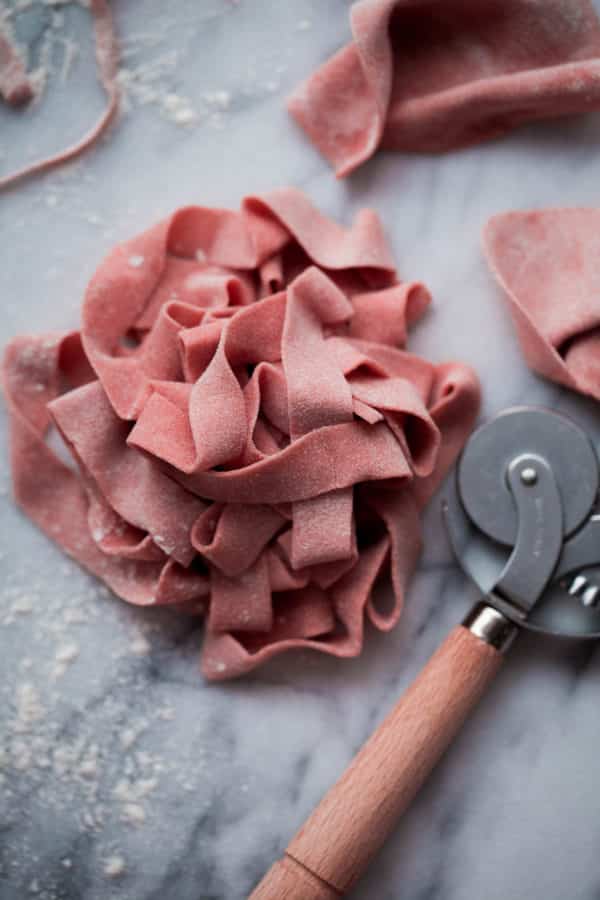
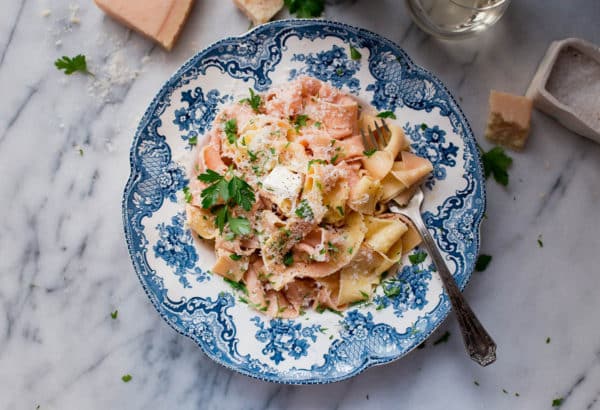
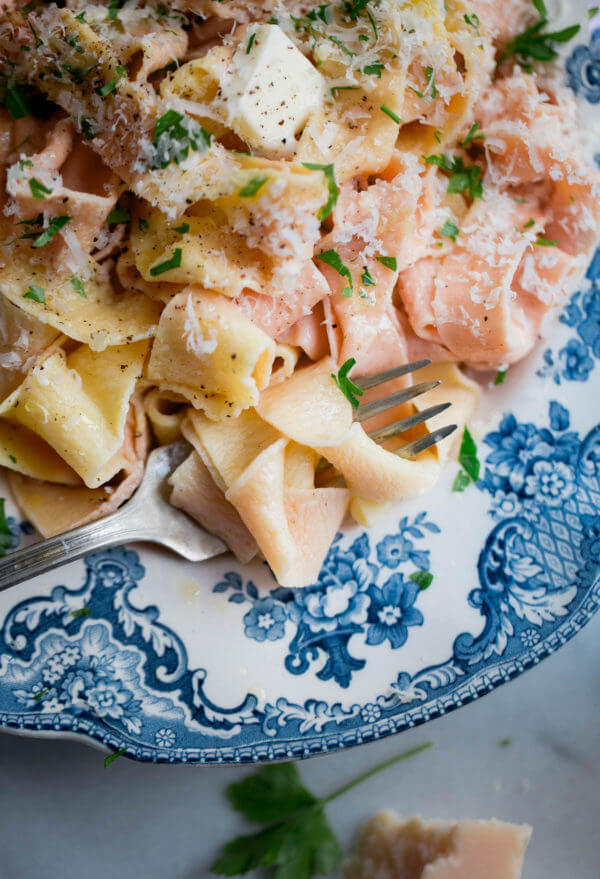
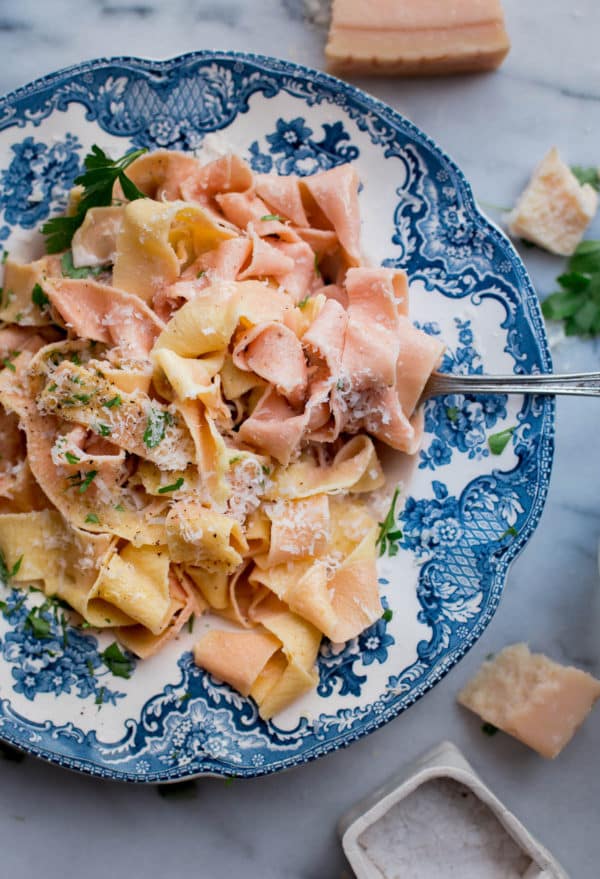

25 Comments on “Homemade Pappardelle Pasta Recipe”
Mine turned out pretty good, but I felt like the noodles were too thick. They were too much in the mouth. I wish I wouldn’t have stopped at setting 4 on my pasta roller. I would to go 6.
Glad the pasta came out well! Definitely adjust the thickness to your taste, there is also a chance that depending on your pasta machine, the settings will vary from what I use and that’s another important thing to consider. Thanks for the feedback!
I made this pasta the day after valintines day because I did not read the beet recipe until THE NEXT DAY. WOW IT WAS WONDERFUL. I MADE IT WITH A SHRIMP GARLIC ONION TOMATO, ADDED CREAM AT THE END IT WAS THE PERFECT VALENTINE MEAL THANKS FOR THE PASTA RECIPE
I made this without a pasta roller and it still came out great!
Easy and fun to make. I have my own chickens and I had some Bob’s Red Mill semolina flour on hand so I decided to make the egg pappardelle to go with wygu boeuf bourguignon for a special Sunday dinner. Your recipe is spot on and the pasta was perfect with the stew. I do not have a pasta or pizza cutter so I used a knife, worked just fine. I highly recommend this recipe and I’m looking forward to trying it with beet puree later in the winter.
So happy to hear this! Thank you so much for coming back and leaving your feedback!
This was very easy and turned out well. Just the right amount of dough in the one small batch for our dinner tonight: pappardelle with mushroom, shallot and prosciutto
The pink pasta looks delicious! Thanks for the recipe! 😀 I recently made blue pasta naturally colored with red cabbage: http://www.sewhistorically.com/homemade-all-natural-blue-pasta
The pink pappardelle is so pretty. I love having colored pasta, like squid ink or other veggies. I don’t have a pasta roller attachment yet and would love to get one and make my own at home.
It’s a lot of fun! I used to have a manual hand roller years and years ago, but the Kitchenaid attachment is PERFECT and makes life a lot easier. I need to make homemade pasta more often, because it really is quite easy once you have a base recipe that you love. Thanks Terri!
OMG that delicate pink pasta! SO perfect for Valentine’s Day. I will need to give this a try!
Thanks so much Jenny!
Laura! That plate right there just made me so happy. I saw your snap on Instagram and had to come over and admire this pink pasta in all its glory! The funny thing is I was just shopping yesterday and saw some white and red pasta hearts and was briefly tempted to buy them but then imagined how corny they would’ve looked! This pink pappardelle (my favourite pasta shape by the way) is how you do Valentine’s Day pasta right, nothing corny about that! Gorgeous photos too.
Thank you so much Julia! 🙂 You’re so sweet, thank you for taking the time to come over and tell me that! Also, so glad you like the photos. I actually contemplated making heart shaped pasta for like two seconds, and decided no one had the energy for that, HA! 😉
Love the beet colored pasta – never tried coloring pasta dough but looks like this will change soon 🙂
It’s really easy! You can also use spinach, squid ink, or tomato paste as other options! 🙂
Ooo, thanks for the tips! I like the tomato paste – will try for sure! Thanks again!
Yup, yup. Pasta is my love language. <–same.
LOVE this. 🙂
YES! I just love it.
PINK PASTA?! Omg. So fun!!!!!!
Yes! So glad you find it as exciting as me! Ha! 🙂
I still haven’t made my own pasta (I know!) but you make it look so easy that I might need to tackle it this weekend! My plan for Valentine’s Day was to pick up dinner from an Italian market we have down the street, but I might skip that in favor of a batch of this 🙂 Also, LOVE the pink pasta! I don’t know if I could get my husband to eat it, but I’m all into it. Such a lovely post! xo
It’s really FUN to make homemade pasta! I really need to do it more often. Kind of meditative 😉 Love the idea of picking up dinner from an Italian market though!!
There is pretty much nothing better than fresh pasta and I especially love pappardelle! But pink pasta?!?! OMG that’s basically my dream come true!
I totally agree!! Thanks so much Sues! Glad someone loves the color just as much as me 😉